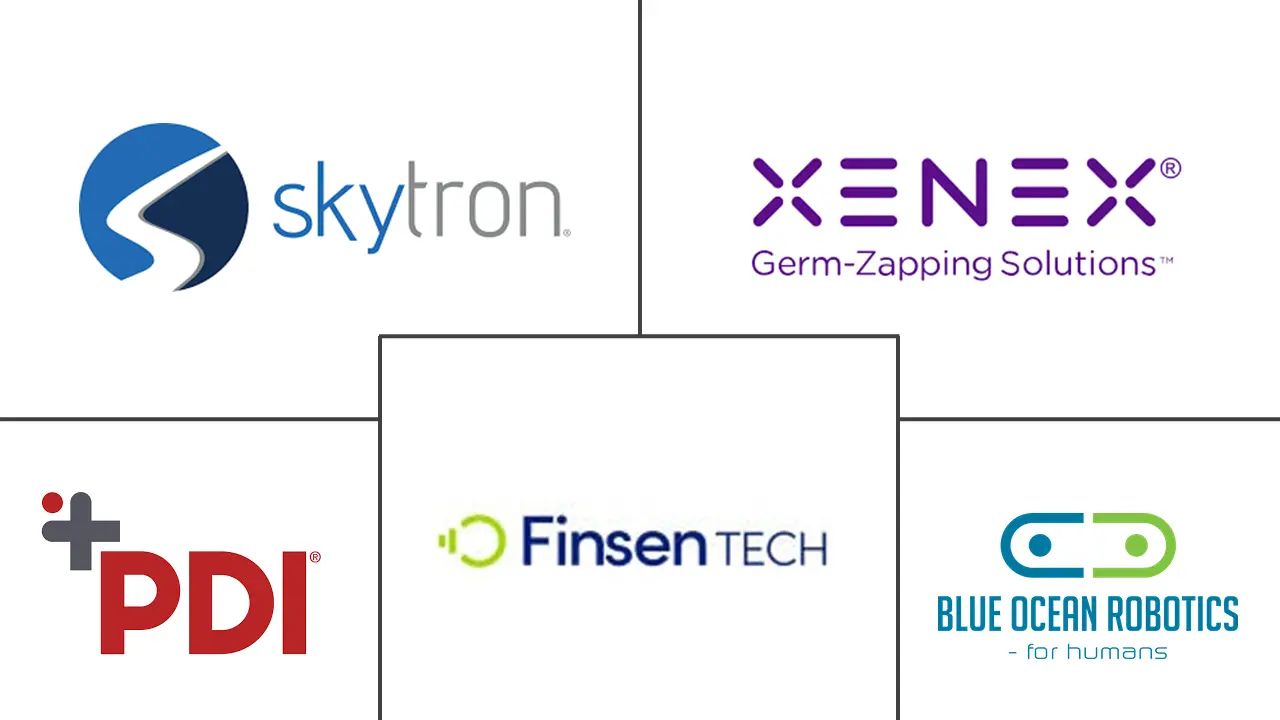Disinfectant Robot Market Size and Share
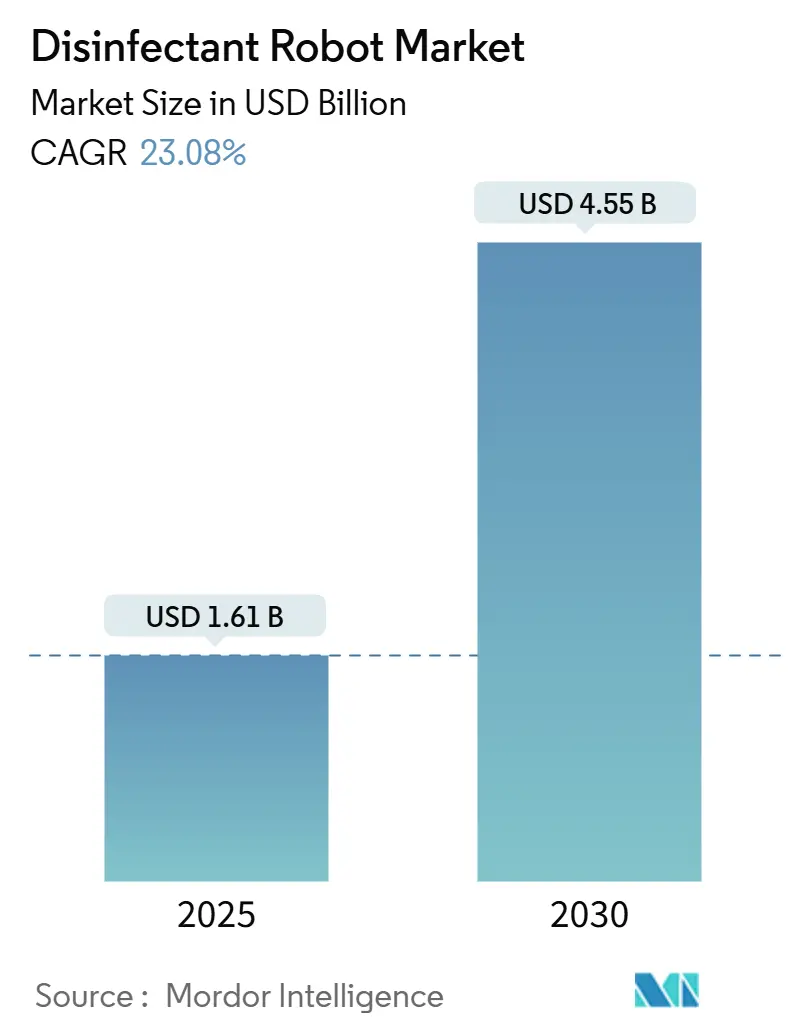
Disinfectant Robot Market Analysis by Mordor Intelligence
The disinfectant robot market size stood at USD 1.61 billion in 2025 and is projected to reach USD 4.55 billion by 2030, reflecting a robust 23.08% CAGR over the forecast period. Heightened post-pandemic vigilance, the financial burden of hospital-acquired infections (HAIs), and tightening regulatory compliance throughout healthcare and public infrastructure are reinforcing the business case for autonomous germicidal devices. Adoption is expanding from acute-care facilities to airports, hotels, and retail chains as visible hygiene becomes a brand differentiator and liability shield. Advances in far-UVC wavelengths, miniaturized hydrogen-peroxide vapor generators, and simultaneous localization and mapping (SLAM) algorithms are shortening cycle times and enabling occupied-space operation, compressing payback periods even when equipment is delivered under subscription models. Vendors are converging on disinfection-as-a-service (DaaS) contracts that convert capital expenditure to operating expense, lowering the USD 75,000–125,000 upfront hurdle and expanding penetration into mid-tier hospitals and small-format retail outlets.
Key Report Takeaways
- By disinfection technology, UV-C is expected to command 63.3% of the disinfectant robot market share in 2024; plasma, ozone, and other modalities are projected to register a 25.56% CAGR through 2030.
- By mobility level, semi-autonomous and tele-operated robots held 46.8% of the disinfectant robot market size in 2024, while fully autonomous mobile robots are forecast to expand at a 25.01% CAGR during the same period.
- By end-user, hospitals and clinics accounted for 51.8% of the disinfectant robot market share in 2024; hospitality and retail facilities are expected to advance at a 26.67% CAGR through 2030.
- By application, hard-surface disinfection led with 47.81% of the disinfectant robot market share in 2024, whereas air and HVAC disinfection is set to grow at a 25.81% CAGR to 2030.
- By geography, North America captured a 38.22% market share of the disinfectant robot market in 2024; however, the Asia Pacific is poised to expand at a 25.69% CAGR over the forecast horizon.
Global Disinfectant Robot Market Trends and Insights
Drivers Impact Analysis
| Driver | (~) % Impact on CAGR Forecast | Geographic Relevance | Impact Timeline |
|---|---|---|---|
| High incidence of hospital-acquired infections | +5.2% | Global, acute in North America and Europe | Medium term (2–4 years) |
| Stringent infection-control regulations | +4.8% | North America and Europe, expanding to Asia Pacific | Long term (≥4 years) |
| Technological advances in UV-C and autonomy | +4.1% | Global, led by robotics hubs | Medium term (2–4 years) |
| Post-COVID surge in infection-prevention budgets | +3.9% | Global, headlined by North America and Europe | Short term (≤2 years) |
| Deployment mandates at major transit hubs | +2.7% | Europe and Middle East, spillover to Asia Pacific | Medium term (2–4 years) |
| Growth of disinfection-as-a-service models | +2.4% | North America and Europe, emerging in Asia Pacific | Long term (≥4 years) |
| Source: Mordor Intelligence | |||
High Incidence of Hospital-Acquired Infections
One in 31 U.S. inpatients suffers an HAI each day, totaling 687,000 infections yearly and costing USD 28–45 billion; similar patterns persist globally.[1]Centers for Disease Control and Prevention, “National and State Healthcare-Associated Infections Progress Report,” CDC.gov While targeted programs trimmed MRSA and CLABSI rates, spore-forming Clostridioides difficile remains stubborn, reinforcing demand for disinfectant robot market deployments that deliver reproducible 3- to 6-log kill levels on hard surfaces within 10–30 minutes. Cost-of-illness estimates indicate that a ventilator-associated pneumonia episode can exceed USD 100,000. Therefore, automated UV-C or hydrogen peroxide cycles that shorten patient room turnover can boost return on investment and elevate infection prevention scores.
Stringent Infection-Control Regulations in Developed Economies
The CMS Hospital-Acquired Condition Reduction Program penalized 1,661 hospitals in FY 2024, withholding 1% of Medicare payments for poor infection metrics, while FDA 510(k) pathways and European MDR 2017/745 require rigorous clinical validation before market entry.[2]Centers for Medicare and Medicaid Services, “Hospital-Acquired Condition Reduction Program,” CMS.gov Accreditation audits now demand auditable hygiene data, incentivizing facilities to adopt disinfectant robot market solutions that automatically log cycle times, delivered dose, and pathogen reduction evidence.
Technological Advances in UV-C and Autonomy Algorithms
Far-UVC at 222 nm inactivates airborne viruses without penetrating skin or corneas, enabling safe occupied-space dosing and circumventing the evacuation protocols inherent to 254 nm lamps.[3]Columbia University Irving Medical Center, “Far-UVC Light Safely Kills Airborne Coronaviruses,” Cuimc.columbia.edu LiDAR-enabled SLAM enables fully autonomous robots to plan routes around dynamic obstacles and integrate with building management systems, reducing manual labor by up to 70%. Miniaturized hydrogen-peroxide vapor emitters further address UV shadowing, broadening the reach of the disinfectant robot market into cluttered spaces.
Post-COVID Surge in Infection-Prevention Budgets
The CDC’s FY 2025 allocation retains USD 24 million for the National Healthcare Safety Network, and ARPA-H dedicated USD 1.5 billion in 2024 to biosecurity technology, catalyzing the procurement of robots that sync with pathogen sensors. Recovery of elective procedure revenue revitalized capital budgets, while DaaS contracts smoothed cash flow by shifting large outlays to monthly fees.
Restraints Impact Analysis
| Restraint | (~) % Impact on CAGR Forecast | Geographic Relevance | Impact Timeline |
|---|---|---|---|
| High capital expenditure and ownership cost | -3.6% | Global, acute in Asia Pacific and South America | Short term (≤2 years) |
| Operational safety and shadowing concerns | -2.8% | Global, stricter in North America and Europe | Medium term (2–4 years) |
| Emerging UV-resistant strains | -1.9% | Global, early evidence in North America and Europe | Long term (≥4 years) |
| Competition from long-lasting antimicrobial coatings | -2.2% | North America and Europe, emerging Asia Pacific | Medium term (2–4 years) |
| Source: Mordor Intelligence | |||
High Capital Expenditure and Total Cost of Ownership
List prices between USD 75,000 and USD 125,000 remain daunting, particularly where environmental services wages are below USD 5 per hour; consumables and annual service add 10–20% to outlays. Budget-strained facilities thus hesitate, particularly when procurement committees undervalue training, maintenance, and the risk of downtime.
Operational Safety and Shadowing Concerns
Room lockdown during 254 nm UV-C cycles inflates turnaround times to nearly an hour. Shadowed zones behind monitors or carts may see only 1- to 2-log reductions well short of benchmarks that necessitate manual wiping, which dilutes labor-saving claims. OSHA’s ozone limit of 0.1 ppm further restricts the deployment frequency of plasma units.
Segment Analysis
By Disinfection Technology: UV-C Dominance Faces Plasma Disruption
UV-C platforms held a 63.3% market share in the disinfectant robot market in 2024, supported by decades of germicidal evidence and FDA Class II clearances that reassure risk-averse buyers. This segment generated the bulk of the disinfectant robot market size, reaching USD 1.02 billion by 2025. Far-UVC’s 222 nm breakthrough unlocks occupied-space use, reducing cycle overhead and broadening adoption in high-traffic venues. Meanwhile, plasma and ozone devices, although nascent, are growing at a 25.56% CAGR as facilities seek solutions that are immune to line-of-sight constraints. Their gaseous radicals diffuse into occluded spaces, yet they must adhere to OSHA ozone limits, tempering near-term penetration.
Second-generation hydrogen-peroxide vapor (HPV) and pulsed-xenon units address deep-clean demands where 6-log spore kills are mandated, sustaining mid-single-digit growth. Vendors now bundle dual-modality payloads, including continuous air purification and high-intensity surface bursts, to hedge efficacy across pathogen niches.
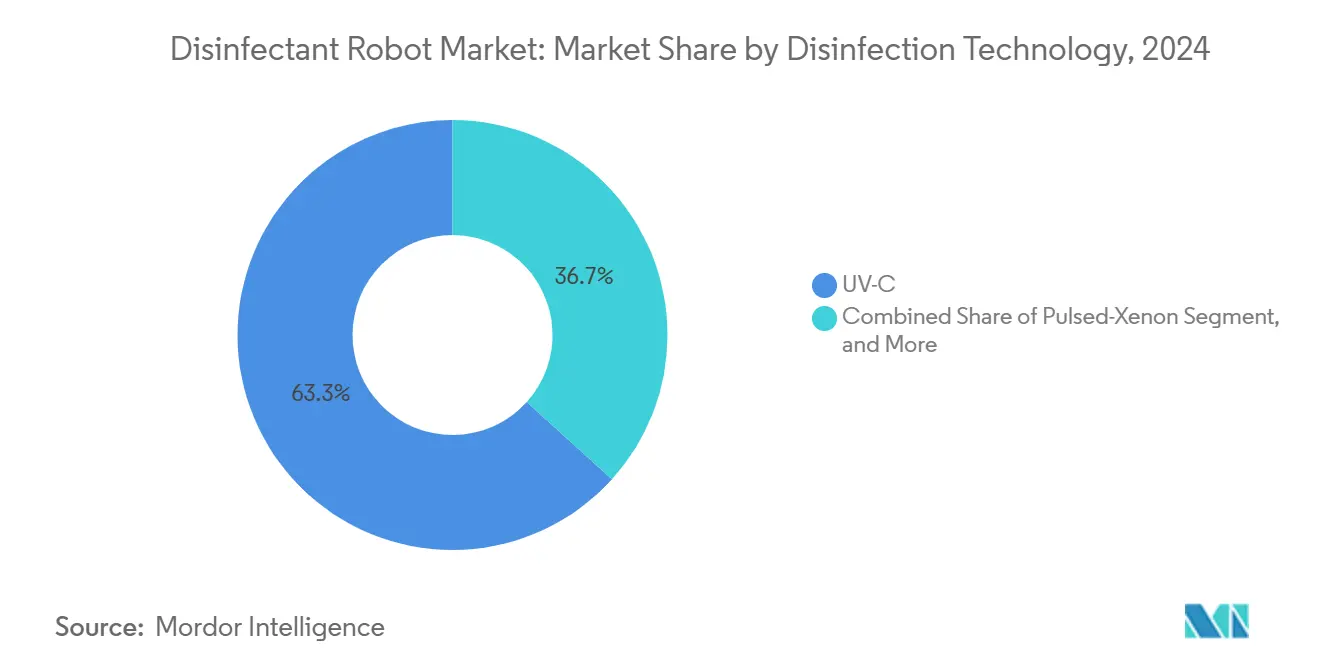
Note: Segment shares of all individual segments available upon report purchase
By Mobility Level: Autonomy Gains Ground as Labor Costs Rise
Semi-autonomous machines retained 46.8% disinfectant robot market size in 2024, appealing to budget-conscious buyers willing to trade operator oversight for 30–40% lower capex. Yet, fully autonomous platforms are forecast to outpace them, expanding at a 25.01% annual rate as high-wage regions seek labor savings. SLAM-equipped robots routinely log 20–30% shorter cycles than manual-push models by optimizing dwell times and dynamic dosing. Cost curves are bending downward as solid-state LiDAR prices fall and open-source autonomy stacks proliferate, eroding the price gap versus tele-operated units.
By End-User: Hospitality Surges as Hygiene Becomes Brand Differentiator
Hospitals and clinics accounted for 51.8% of revenue in 2024, yet growth is moderating toward the mid-teens as base penetration increases. In contrast, hospitality and retail are expected to post a 26.67% CAGR as visible robot patrols increase consumer confidence. Hotels cite 5–10% occupancy premiums and positive review sentiment when autonomous UV-C units sanitize lobbies and elevators after midnight. Grocery chains follow suit, operating robots during stocking shifts to disinfect carts and checkout belts without disrupting shoppers.
Transportation hubs, spurred by Heathrow’s April 2025 deployment, represent a showcase vertical where infectious disease optics intersect with public safety mandates. Educational campuses are transitioning from pilot to rollout phases as parents balance pathogen risk with academic quality.
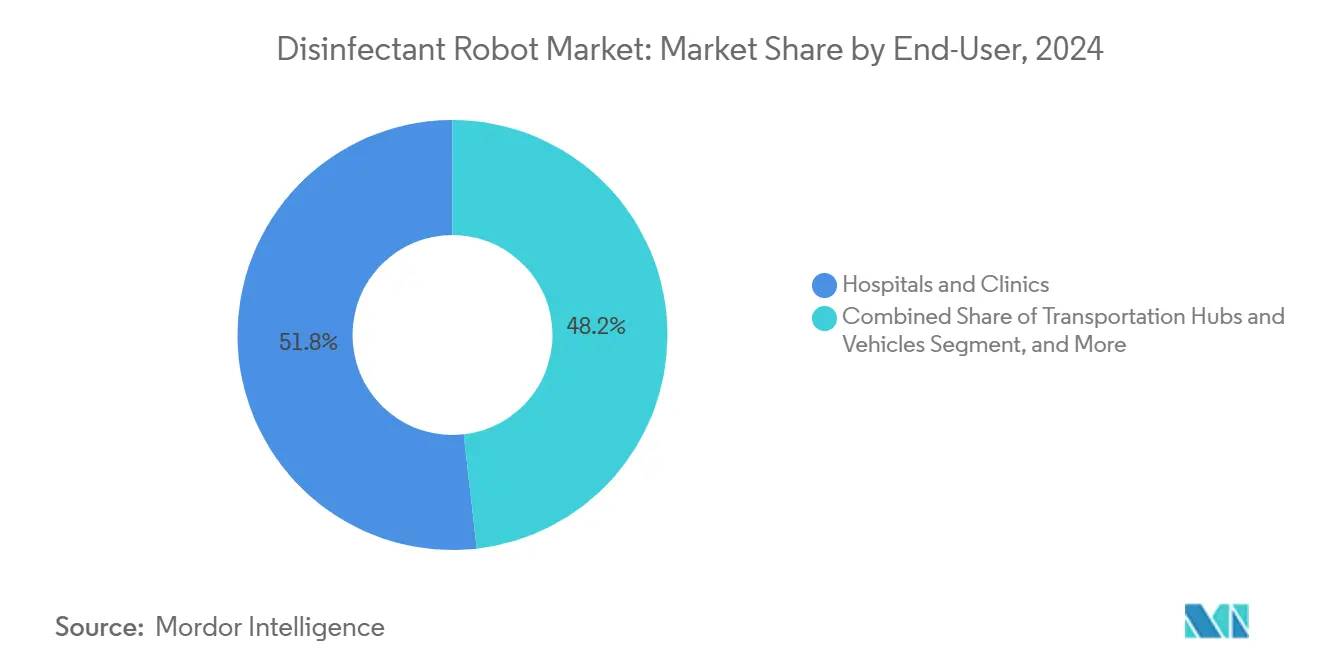
Note: Segment shares of all individual segments available upon report purchase
By Application: Air Disinfection Accelerates with ASHRAE Standards
Hard-surface disinfection generated 47.81% of 2024 revenue, yet air and HVAC applications are scaling faster at 25.81% CAGR. ASHRAE guidelines now endorse upper-room UV-C and far-UVC fixtures, legitimizing continuous air treatment. Robots equipped with 222 nm emitters traverse occupied concourses, ensuring a 3-log reduction in airborne pathogens while custodial staff address surfaces. In-duct modules, priced from USD 50,000 upward, integrate with building automation to modulate intensity based on airflow and occupancy.
Equipment and device niches, such as endoscope channels and surgical instruments, lean on hydrogen-peroxide vapor bots that penetrate lumens unreachable by UV. These specialty systems, although smaller in volume, yield premium pricing and serve as beachheads in pharmaceutical production and biosafety labs.
Geography Analysis
North America generated 38.22% of 2024 revenue and maintains momentum through FDA Class II clearances and CMS penalty structures that tie reimbursement to HAI metrics. Academic medical centers remain early adopters, while mid-tier hospitals pivot toward DaaS to sidestep capital approval requirements. Airports from Pittsburgh to Seattle broadcast UV-C robot runs overnight, reinforcing public perception of proactive hygiene.
Asia Pacific, charting a 25.69% CAGR, benefits from China’s hospital-build boom and Japan’s robotics prowess. Domestic Chinese vendors have introduced semi-autonomous units under USD 10,000, catalyzing uptake across tier-2 cities. South Korea and Singapore integrate robots into smart-building ecosystems, scheduling cycles via IoT dashboards. India’s price sensitivity favors subscription models bundled with maintenance, bridging affordability gaps.
Europe holds a mid-teens slice, shaped by strict MDR requirements that privilege ISO 13485 holders and CE marks. The United Kingdom’s National Health Service, constrained by budgetary limitations, relies on service contracts, while Germany’s Fraunhofer-backed UVC-LED innovations drive energy efficiency. Middle East mega-projects in Saudi Arabia and the UAE deploy UV-C fleets in medical-tourism hubs, positioning infection control as a differentiator. Africa sees pilot programs in South Africa and Nigeria backed by donor grants that emphasize labor-saving and data-logging capabilities.
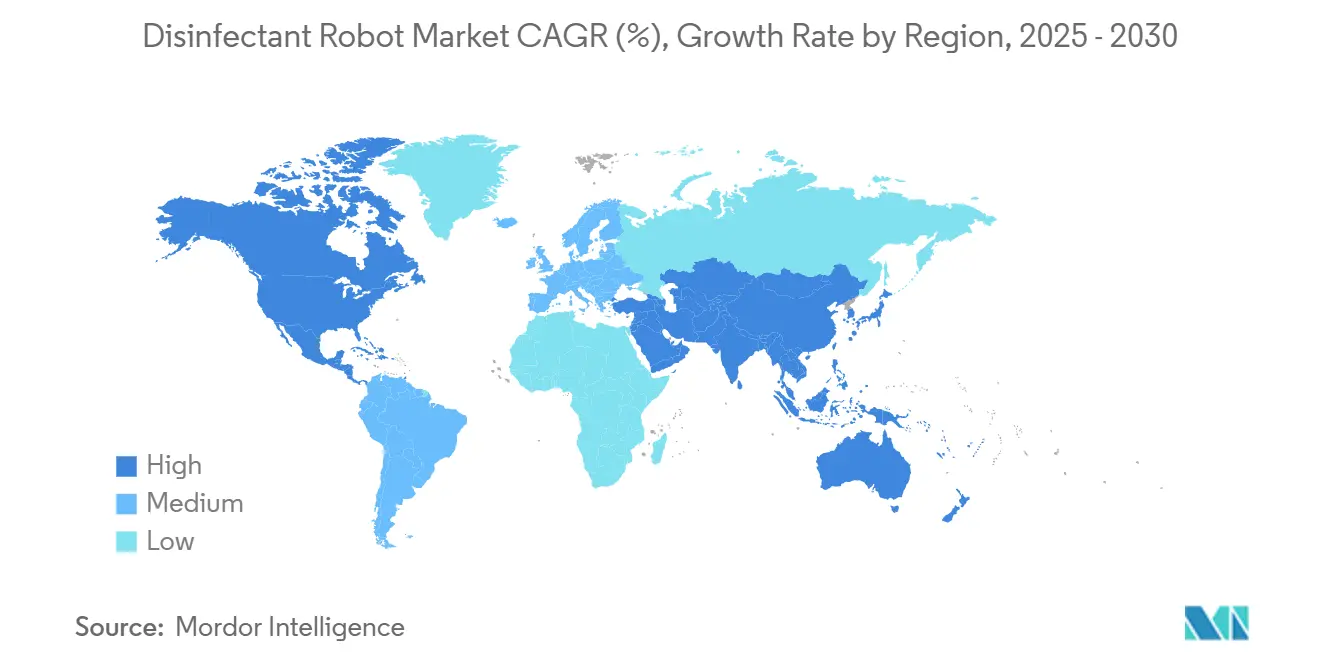
Competitive Landscape
The disinfectant robot market is moderately concentrated, with the five largest vendors collectively capturing approximately 42% of the 2024 revenue. Blue Ocean Robotics leads the development of fully autonomous UV-C units, leveraging Heathrow’s showcase deployment to expand into transit and hospitality. Xenex Disinfection Services dominates pulsed-xenon niches, recently sealing a 500-unit DaaS pact worth USD 37.5 million with a U.S. hospital chain. Bioquell (Ecolab) champions hydrogen peroxide vapor for pharmaceutical cleanrooms, while UVDI supplies fixed UV-C installations paired with real-time dosimetry.
Price compression looms as Chinese and Indian entrants launch sub-USD 10,000 robots, prompting incumbents to bundle analytics portals and pathogen sensors for differentiation. Patent records highlight far-UVC emitters and advanced SLAM, narrowing technology gaps. Regulatory credentials such as FDA 510(k) and CE mark remain barriers, yet startups partner with contract manufacturers specializing in ISO 13485 to expedite compliance.
Strategic priorities center on service delivery. Vendors pitch disinfectant robot market contracts with uptime guarantees, consumables, and quarterly efficacy audits, recasting robots as operational line items rather than capital assets. Expansion into education, warehousing, and mass transit broadens addressable revenue and dilutes healthcare concentration risk.
Disinfectant Robot Industry Leaders
-
Blue Ocean Robotics A/S
-
Xenex Disinfection Services LLC
-
Finsen Technologies Ltd
-
Skytron LLC
-
PDI Healthcare Inc.
- *Disclaimer: Major Players sorted in no particular order
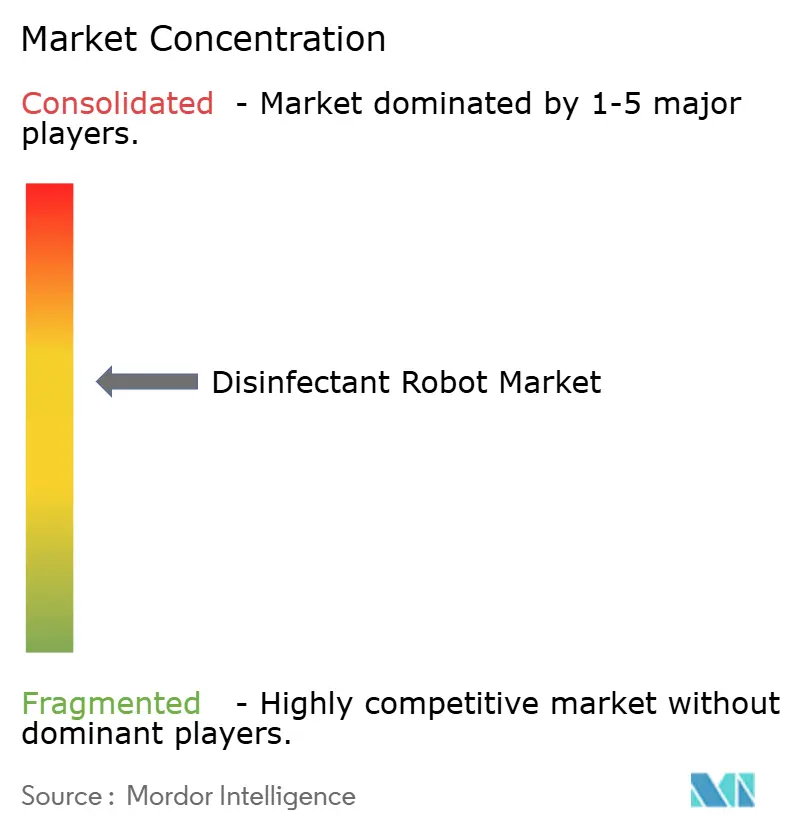
Recent Industry Developments
- April 2025: Heathrow Airport rolled out Blue Ocean Robotics UVD Robots for overnight terminal disinfection, integrating SLAM navigation with building-management systems
- March 2025: Xenex signed a USD 37.5 million, 500-unit pulsed-xenon DaaS contract with a major U.S. hospital chain
- February 2025: Bioquell (Ecolab) debuted a miniaturized hydrogen-peroxide vapor robot that cuts cycle time to 45 minutes
- January 2025: Finsen Technologies raised USD 15 million Series B to scale far-UVC robot production targeting Japan and South Korea
Global Disinfectant Robot Market Report Scope
The Disinfectant Robot Market Report is Segmented by Disinfection Technology (UV-C, Hydrogen Peroxide Vapour, Pulsed-Xenon, Plasma / Ozone and Other Disinfection Technology), Mobility Level (Fully Autonomous Mobile Robots, Semi-Autonomous/Tele-operated Robots, Manual-Push Platforms), End-User (Hospitals and Clinics, Transportation Hubs and Vehicles, Hospitality and Retail Facilities, Educational and Government Buildings, Industrial and Other Commercial Sites, Other End-Users), Application (Hard-Surface Disinfection, Air and HVAC Disinfection, Equipment and Device Disinfection, Other Application), and Geography (North America, South America, Europe, Asia Pacific, Middle East and Africa). The Market Forecasts are Provided in Terms of Value (USD).
| UV-C |
| Hydrogen Peroxide Vapour |
| Pulsed-Xenon |
| Plasma / Ozone and Other Disinfection Technology |
| Fully Autonomous Mobile Robots |
| Semi-Autonomous / Tele-operated Robots |
| Manual-Push Platforms |
| Hospitals and Clinics |
| Transportation Hubs and Vehicles |
| Hospitality and Retail Facilities |
| Educational and Government Buildings |
| Industrial and Other Commercial Sites |
| Other End-user |
| Hard-Surface Disinfection |
| Air and HVAC Disinfection |
| Equipment and Device Disinfection |
| Other Application |
| North America | United States | |
| Canada | ||
| Mexico | ||
| South America | Brazil | |
| Argentina | ||
| Rest of South America | ||
| Europe | Germany | |
| United Kingdom | ||
| France | ||
| Italy | ||
| Spain | ||
| Russia | ||
| Rest of Europe | ||
| Asia Pacific | China | |
| Japan | ||
| India | ||
| South Korea | ||
| Australia | ||
| Rest of Asia Pacific | ||
| Middle East and Africa | Middle East | Saudi Arabia |
| United Arab Emirates | ||
| Turkey | ||
| Rest of Middle East | ||
| Africa | South Africa | |
| Nigeria | ||
| Egypt | ||
| Rest of Africa | ||
| By Disinfection Technology | UV-C | ||
| Hydrogen Peroxide Vapour | |||
| Pulsed-Xenon | |||
| Plasma / Ozone and Other Disinfection Technology | |||
| By Mobility Level | Fully Autonomous Mobile Robots | ||
| Semi-Autonomous / Tele-operated Robots | |||
| Manual-Push Platforms | |||
| By End-user | Hospitals and Clinics | ||
| Transportation Hubs and Vehicles | |||
| Hospitality and Retail Facilities | |||
| Educational and Government Buildings | |||
| Industrial and Other Commercial Sites | |||
| Other End-user | |||
| By Application | Hard-Surface Disinfection | ||
| Air and HVAC Disinfection | |||
| Equipment and Device Disinfection | |||
| Other Application | |||
| By Geography | North America | United States | |
| Canada | |||
| Mexico | |||
| South America | Brazil | ||
| Argentina | |||
| Rest of South America | |||
| Europe | Germany | ||
| United Kingdom | |||
| France | |||
| Italy | |||
| Spain | |||
| Russia | |||
| Rest of Europe | |||
| Asia Pacific | China | ||
| Japan | |||
| India | |||
| South Korea | |||
| Australia | |||
| Rest of Asia Pacific | |||
| Middle East and Africa | Middle East | Saudi Arabia | |
| United Arab Emirates | |||
| Turkey | |||
| Rest of Middle East | |||
| Africa | South Africa | ||
| Nigeria | |||
| Egypt | |||
| Rest of Africa | |||
Key Questions Answered in the Report
What is the current value of the disinfectant robot market?
The disinfectant robot market size reached USD 1.61 billion in 2025 and is forecast to hit USD 4.55 billion by 2030.
Which disinfection technology leads global adoption?
UV-C robots dominate with 63.3% market share, backed by extensive clinical validation and regulatory clearances.
How fast is Asia Pacific expanding?
Asia Pacific is projected to grow at a 25.69% CAGR through 2030, propelled by China’s hospital build-out and Japan’s robotics ecosystem.
Why are hospitality venues adopting robots?
Hotels and retailers use visible robotic disinfection to win customer trust, driving a 26.67% CAGR in that end-user segment.
What business model trends are emerging?
Disinfection-as-a-service contracts convert large capital outlays into monthly operating fees, easing adoption for mid-tier facilities.
Who are the key players in disinfectant robots?
Blue Ocean Robotics, Xenex Disinfection Services, Bioquell (Ecolab), UVDI, and Skytron collectively hold about 42% of global revenue.
Page last updated on:
